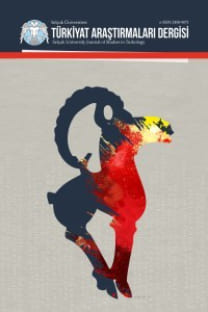Dârülelhan Derlemeleri ve Anadolu Halk Şarkıları Külliyatının Melodi, Ritim ve Güfte Açısından İncelenmesi
Türk müzik kültüründe sahada yapılan derleme çalışmalarının kurumsal ilk örneği Dârülelhân derlemeleridir. Bu saha çalışmalarına döneminin önemli müzik şahsiyetleri katılmış ve yaklaşık 1000 halk türküsü, oyun havası derlenmiştir. Derlenen eserler 15 defterlik bir külliyat halinde yayımlanmıştır. Dönemin müzik gelişmeleri ve derlemeler esnasında benimsenen notasyon yaklaşımı nedeni ile eserlerin kayıt altına alınmasında günümüz bakış açısıyla bazı sorunların oluştuğundan bahsedilebilir. Bahsi geçen nedenlerden dolayı derlenen eserlerin önemli bir kısmı yaygınlaşmamış ve külliyat içerisinde saklı kalmıştır. Araştırmada; doküman analizi yöntemi ile veriler elde edilmiştir. 15 defter halinde yayımlanan 677 halk türküsü ve oyun havası incelenmiştir. Eserlerde göze çarpan notasyon sorunlarının neler olduğu melodi, ritim ve güfte yapısı açısından belirlenmeye çalışılmıştır. Yapılan inceleme sonucu külliyatta bulunan eserlerde günümüz notasyon anlayışına göre farklı bir notalama yaklaşımının kullanıldığı anlaşılmıştır. Ayrıca külliyatta bulunan notasyonların, Batı müziği nota yazım tekniklerinin geleneksel müziklerde kullanımının anlaşılması adına önem arz ettiği görülmüştür. Bu notasyonların dönemin müzik politikasını, anlayışını ve müzikal bakış açısını anlamakta büyük ölçüde önemli olduğu anlaşılmıştır. Araştırmadan elde edilen veriler ışığında, derlemecilerin dönemsel müzikal düşünce tarzları ve tutumları da ortaya konmaya çalışılmıştır. Bu düşünce tarzı ve tutumların genellikle notalama yaklaşımında ortaya çıktığı, sergiledikleri bu yaklaşımın ise kimi zaman ilgili müzik eserinde yapısal farklılaşmalara neden olduğu anlaşılmıştır.
Anahtar Kelimeler:
Türk Halk Müziği, Dârülelhân, Derleme, Anadolu Halk Şarkıları Külliyatı
Dârülelhan Compilations and An Analysis of the Collection of Anatolian Folk Songs Corpus in Terms of Melody, Rhythm and Lyrics
The first institution of compilation studies in the field in Turkish music culture is Dârülelhân compilation. Important musical figures of the period participated in these field studies and approximately 1000 folk songs and folk-dance melodies were compiled. The collected songs were published as a corpus of 15 magazines. Due to the musical developments of the period and the notation approach adopted during compilations, it can be mentioned that there are some problems with today's point of view in recording the songs. Due to the reasons, a significant part of the collected songs was not widespread and remained hidden in the corpus. In this study; because of the compilations of Dârülelhân, 677 folk songs and folk-dance melodies published in 15 magazines were examined. The data needed in the research were obtained by document analysis method. The notation problems that stand out in the songs have been tried to be determined in terms of melody, rhythm, and lyrics structure. As a result of the examination, it was understood that a different notation approach was used in the songs found in the corpus compared to today's notation approach. In addition, it has been seen that the notations in the corpus are important for understanding the use of Western music notation techniques in traditional music. It is understood from these research data that these notations are also very important in understanding the music policy, understanding and musical point of view of the period. In the light of the data obtained from the research, the periodical musical thinking styles and attitudes of the compilers were also tried to be revealed. It has been understood from the musical analysis conducted during the research process that these thinking styles and attitudes generally emerge in the notation approach, and that this approach they exhibit sometimes causes structural differences in the relevant musical work.
Keywords:
Turkish Folk Music, Dârülelhân, Compilation, Anatolian Folk Songs Corpus,
- ISSN: 1300-5766
- Yayın Aralığı: Yılda 3 Sayı
- Başlangıç: 1994
- Yayıncı: Selçuk Üniversitesi
Sayıdaki Diğer Makaleler
Kumluca (Antalya) Ağzından Derleme Sözlüğü’ne Katkılar
Lise Öğrencilerinin Osmanlı Türkçesi Dersiyle İlgili Görüşleri
Mustafa YILDIZ, Beyza GÜLER GÜNEŞ
Muğla-Yatağan İlçesi Eskihisar’da Türk Dönemi Eserleri
Osman KUNDURACI, Nurcan BAHARGÜLÜ, Elif YİĞİTER
Dilbilgisel Kanıtsallık İşaretleyicilerinin Sözlükselleşmesi: Özbek Türkçesinde mish-mish(lar)
Osmanlı-Safevi Savaşlarında Kırım Tatarlarının Rolü
Geç Dönem Çağatay Türkçesinde Nasreddin Hoca Fıkraları
Oğuzhan KARABURGU, Fatih ERBAY
Sümerbank Ereğli Pamuklu Dokuma Fabrikası (1934-1997)
Derviş Mahmud’un Terceme-i Sevâkıb’ı ve Dil Özellikleri
22 Numaralı Anadolu Ayniyat Defterine Göre Anadolu Eyaletinin Merkez-Taşra İlişkileri
